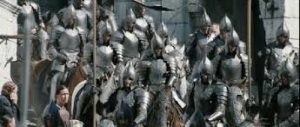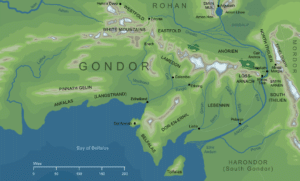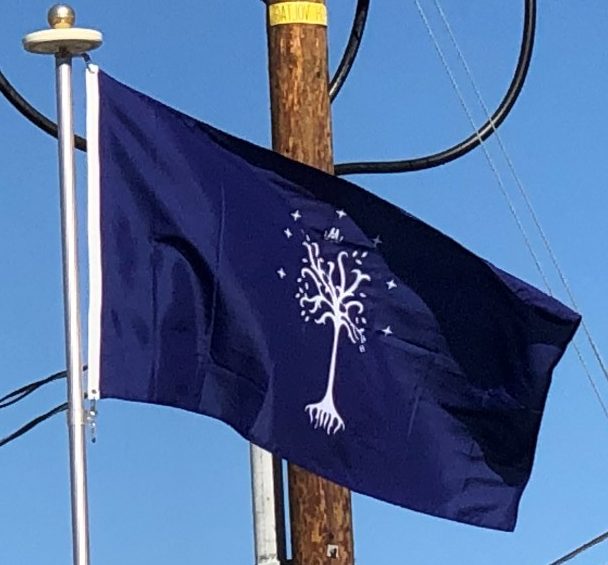
Third Age:
Gondor’s armies prevented Mordor and its allies from overwhelming the rest of Middle-earth. Gondor was in a very crucial position, in order to guard Middle Earth and because of Gondor’s proximity to Mordor, its military forces had to be proficiently trained and vigilantly on guard at all times. Because of this, they were arguably the strongest country that opposed Sauron. During the Third Age, most of Minas Tirith’s armies were trained and drilled to fight in tight infantry formations, supported by archers and cavalry. Their armaments consisted of a chainmail undercoat with either a black tabard or plate armor over it. Their standard weapons were long spears, longswords, and longbows, complimented by tower shields.
Minas Tirith’s immediate defenses comprised thousands of infantrymen stationed throughout Osgiliath, Cair Andros, and the Rammas Echor. These units were most likely temporary detachments from the city. Minas Tirith also had at least three companies of the elite Guards of the Citadel, tasked to defend the upper levels of the city. They wore black robes, surcoats and winged silver crowns. The Guards of the City were not allowed to go in the main part of the City in their uniform. Additionally, the sixth level of the city housed stables for a small force of horsemen. Beyond Anduin and the defenses of Minas Tirith operated a secretive group of soldiers called the Rangers of Ithilien The Rangers of Ithilien had guerrilla warfare aginst the Southrons, allies of Mordor. Similar to the Rangers of the North, the Rangers of Ithilien were comprised of the remnant of the Dúnedain in their respective Kingdom, in this case being the Dúnedain that once dwelled in Ithilien.(the Rangers of the North were Arnorian Dúnedain, while the Rangers of Ithilien are Gondorian- and were more populous than their northern kin). Armed with longbows, swords, and spears, these men watched and harassed the enemy throughout Ithilien, much akin to guerrilla warfare. The captain of the Rangers of Ithilien during the War of the Ring was Faramir, the younger brother of Boromir and the son of the Steward of Gondor, Denethor II.
The defense of Gondor’s fiefdoms were the responsibility of the respective lords of these territories. Their training, strength in numbers, and armaments varied from each fief (Lossarnach brought axemen to the aid of Minas Tirith while the men of Morthond Vale consisted of archers). The greatest of these fiefs was Dol Amroth, which brought forth the largest force to Minas Tirith, made up of men-at-arms and arguably the best cavalry in Middle Earth- the elite Swan Knights.
Gondor’s fleet at the time of the War of the Ring was docked at Pelargir. This port and the Anduin River was essential in the defense of Minas Tirith. As made evident by the fiefdom’s dire need to defend their coasts and many rivers of Gondor, a majority of the fleet was concentrated at Pelargir. This fleet was destroyed when the Black Ships of Umbar attacked, enslaving many of Gondor’s sailors into the service of Mordor.
Etymology:
Gondor name means ‘Land of Stone’, from Sindarin gond (stone) + (n)dor (land), most likely given to it because of the White Mountains (Ered Nimrais) and other mountain chains in the land.
Regions of Gondor:

- Gondor was divided between several nearly autonomous regions. These were the following:
- Ithilien, a region along the east bank of the Anduin river under the shadow of the Ephel Dúath (Mountains of Shadow). Ithilien was abandoned and mostly under the control of Mordor during The War of the Ring. (Although Gondor did have secret bases throughout the region such as Henneth Annûn, and the Rangers of Ithilien used guerilla warfare tactics to harass the enemy throughout Ithilien, and disrupt supply lines and companies marching to and from Mordor. After the War of the Ring, Faramir was made Lord Paramount of Ithilien by Aragorn.
- South Ithilien, a portion of the the Ithilien south of Osgiliath. The road (the Harad Road) the Southrons took to get to Morder lied here.
- Anórien, a strip of land along the northern edge of the White Mountains. Bordered by the Mering Stream and Rohan to the west, Anduin to the east, the Mouths of Entwash to to the north, and the White Mountains and Rammas Echor to the south.
- Lossarnach, a heavily-populated farmland region southwest of Minas Tirith.
- Lebennin, a plain extending from the White Mountains down to the Bay of Belfalas that bordered Lossarnach.
- Belfalas, a fiefdom ruled by the Princes of Dol Amroth.
- Dor-en-Ernil, a narrow strip of land along the Bay of Belfalas ruled by the Princes of Dol Amroth.
- Lamedon, a plain between the White Mountains and the River Ringló.
- Anfalas or Langstrand, a narrow strip of land along the sea bordered by the Pinnath Gelin.
- Andrast, The western-most province of Gondor located on a narrow peninsula jutting out into the Sea.
- Ringló Vale, a mini-province.
- Morthond or Blackroot Vale, where Duilin comes from.
- The long cape of Andrast was not populated (by the descendants of Númenóreans, but evidence from the Unfinished Tales suggests that a small group of Púkel-men inhabited it.)
- Additionally, Gondor held or had held the following regions at certain points in its history:
- South Gondor or Harondor, an arid region between the rivers Poros and Harnen, which was contested between Gondor and Harad.
- Calenardhon, which was given to the Éothéod and became Rohan. It’s boundaries were the rivers of Anduin in the east, Isen in the west, Limlight in the north, and the White Mountains/ Mering Stream in the south.
- Enedwaith, a region between the rivers Isen and Greyflood. It was never truly populated by Gondor and was soon abandoned.
- Rhovanion, which was never fully under the control of Gondor but under Gondorian control at certain times during the Third Age.
- Ephel Dúath, the Mountains of Shadow, which was the extreme eastern region of Gondor where she kept watch over Mordor with many fortresses and cities such as Minas Ithil, Durthang, and the Tower of Cirith Ungol. Evil things re-entered Mordor after Gondor’s watch upon the land slackened during the Second Age.
Cities, Fortresses, and Strongholds in Gondor included:
- Cair Andros, an island-fortress in the river Anduin, roughly 40 miles north of Osgiliath. Gondor maintained a steady garrison here, as it was of paramount importance to Gondor during the long war with Mordor, in order to prevent the enemy from crossing the river and entering into Anórien.
- Calembel, a city in Lamedon.
- Dol Amroth, a city in Belfalas ruled by the Prince of Dol Amroth.
- Ethring, a ford and a large township built on either side of the river Ringló.
- Henneth Annûn, a hidden refuge of Gondorian rangers in the northern part of Ithilien along the Ephel Duath, the Mountains of Shadow.
- Linhir, a port city in Lebennin.
- Minas Tirith (originally Minas Anor), City of the Kings, the capital (Third Age) and largest city of Gondor.
- Osgiliath, a city and former capital of Gondor on the river Anduin, largely destroyed and abandoned by the end of the Third Age. During the War of the Ring, Gondor kept a garrison on the west bank to prevent the Enemy from crossing the river and assaulting Minas Tirith. Osigiliath was the key to besiege Minas Tirith because of its location and access to the river. Although the massive Morgul-host led by the Witch-King to beseige Minas Tirith overwhelmed the garrison, and drove the Gondorians out thus gaining the passage of Anduin- the true beginning of the Siege of Gondor that would conclude at the Battle of the Pelennor Fields. King Elessar had it rebuilt after Sauron’s downfall.
- Pelargir, the great southern harbour, which was captured by the Corsairs during the War of the Ring. The people of Pelargir helped in the Batttle of Pell
Tarnost, a hill-town in Belfalas.
Additionally, Gondor had held the following locations at certain points in its history:
- Angrenost (Isengard), one of the three Fortresses of Gondor and held within it one of the realm’s Palantiri. Its location in Nan Curunir (valley at the end of the Misty Mountains), was at the northwestern corner of the Southern Kingdom of Gondor, guarding the Fords of Isen from enemy incursions into Calenardhon, and together with the fortress of Helm’s Deep to its south protected the Gap of Rohan. After Calenardhon was given to the Éothéod by Cirion, Steward of Gondor and became Rohan, Isengard remained part of Gondor, and the company of Aglarond removed to the northern fortress, although the rest of Gondor almost forgot about it. The small guard intermarried much with the Dunlendings , until the place became a Dunlending fortress in all but name. Orthanc, however, remained closed, as the Steward of Gondor still held the keys. Isengard soon came all but deserted.
- Durthang, the largest fortress in Mordor, originally built to guard the Ephel Dúath (Mountains of Shadow).
- Erech, a town of Gondor that was abandoned by the end of the Third Age. To the north lay the Paths of the Dead.
- Minas Ithil, a city founded by Isildur that was originally the sister city of Minas Anor. Located in an upland valley at the feet of the Mountains of Shadow, it was built as a fortress city to defend Gondor from Sauron in Mordor. It was later conquered by the Nazgûl and renamed Minas Morgul.
- Tharbad, a city on both sides of the river Greyflood, (at one time held by Gondor in the south and Arnor in the north) but abandoned as Gondor’s borders recessed through Enedwaith to the Isen, and later ruined.
- Tower of Cirith Ungol, a Tower Fortress in western Mordor built by Gondor to guard the pass of Cirith Ungol from any evil creature trying to enter -or leave- Mordor. The Great Plague wiped out the garrison located here, so it was easily captured when Sauron’s minions re-entered Mordor.
- Towers of the Teeth, two towers situated on either side of the Black Gate. The two towers, called Carchost and Narchost, that stand on either side of Cirith Gorgor, the Haunted Pass, which lies between the Ephel Dúath (Mountains of Shadow), and the Ash Mountains. Originally built by Men of Gondor following the downfall of Sauron at the end of the Second Age, the Towers of the Teeth were eventually taken over by the servants of the Dark Lord. They were then repaired and fortified and were incorporated into the defenses of the pass and gate.
- Umbar, the far southern harbour which was lost and reclaimed several times, in the end being the home of Black Númenóreans, the Corsairs of Umbar.
